Information Systems Analysis For Australian Labs Assessment 2022
VerifiedAdded on 2022/09/26
|13
|1882
|24
AI Summary
1.Do not use blogs or any generic web sites as resources. 2.References must be journals, articles, books etc. 3.Google scholar. 4.Harvard style referencing is must.(only harvard referencing style) 5. Need not attach the spreadsheet I will attach the project cost benefit analysis spreadsheet. Deadline:18-02-2020
Contribute Materials
Your contribution can guide someone’s learning journey. Share your
documents today.
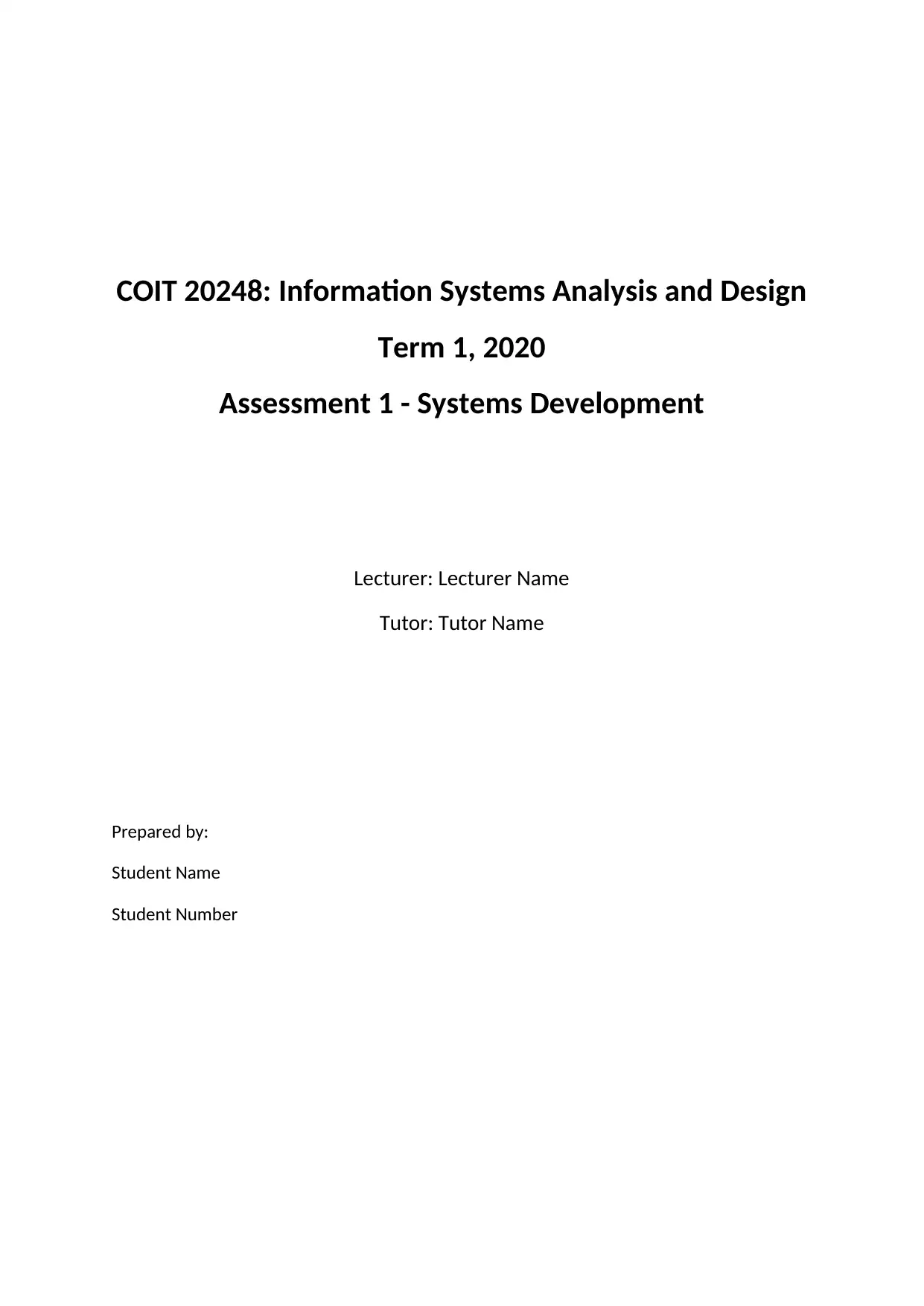
COIT 20248: Information Systems Analysis and Design
Term 1, 2020
Assessment 1 - Systems Development
Lecturer: Lecturer Name
Tutor: Tutor Name
Prepared by:
Student Name
Student Number
Term 1, 2020
Assessment 1 - Systems Development
Lecturer: Lecturer Name
Tutor: Tutor Name
Prepared by:
Student Name
Student Number
Secure Best Marks with AI Grader
Need help grading? Try our AI Grader for instant feedback on your assignments.
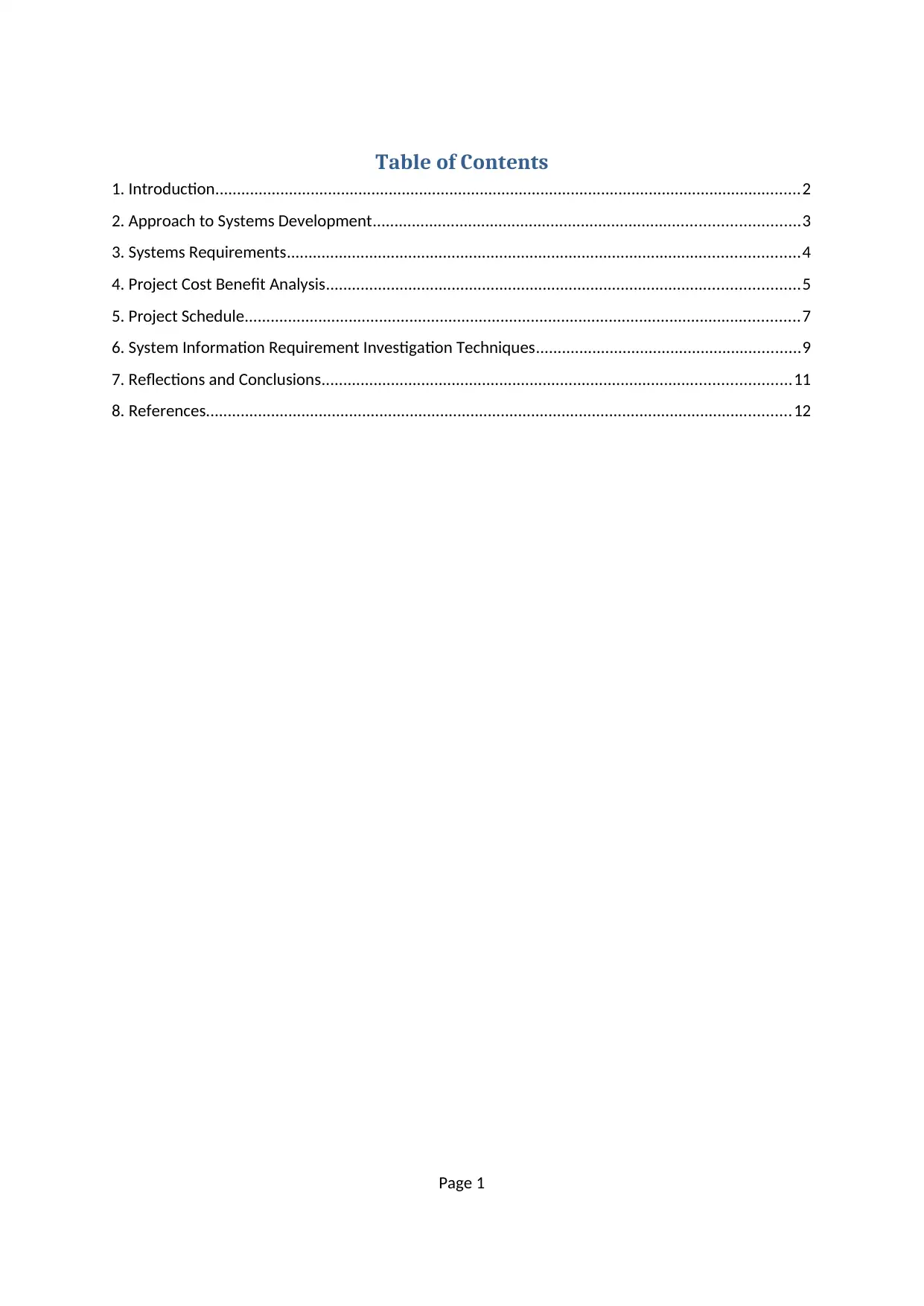
Table of Contents
1. Introduction.......................................................................................................................................2
2. Approach to Systems Development..................................................................................................3
3. Systems Requirements......................................................................................................................4
4. Project Cost Benefit Analysis.............................................................................................................5
5. Project Schedule................................................................................................................................7
6. System Information Requirement Investigation Techniques.............................................................9
7. Reflections and Conclusions............................................................................................................11
8. References.......................................................................................................................................12
Page 1
1. Introduction.......................................................................................................................................2
2. Approach to Systems Development..................................................................................................3
3. Systems Requirements......................................................................................................................4
4. Project Cost Benefit Analysis.............................................................................................................5
5. Project Schedule................................................................................................................................7
6. System Information Requirement Investigation Techniques.............................................................9
7. Reflections and Conclusions............................................................................................................11
8. References.......................................................................................................................................12
Page 1
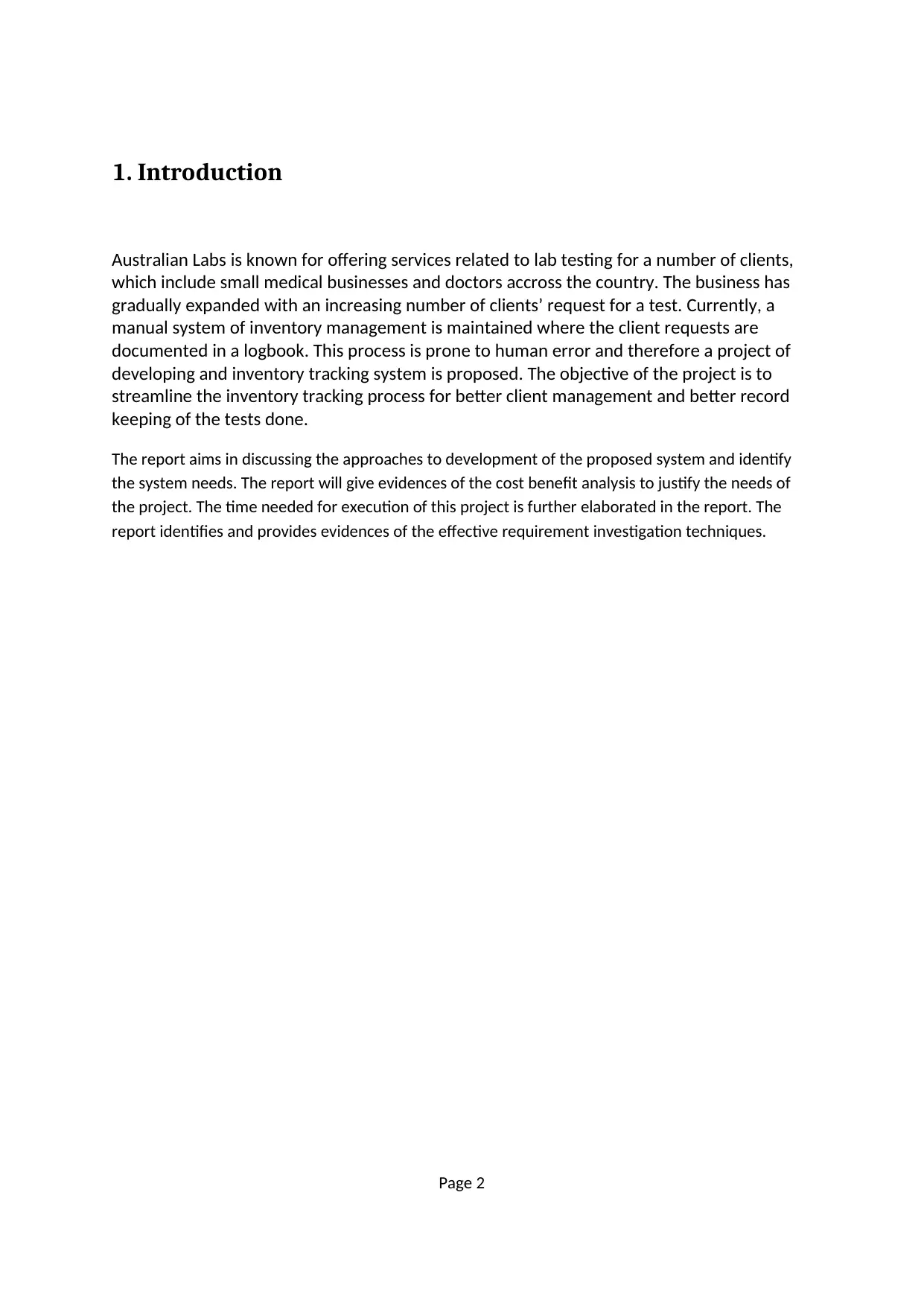
1. Introduction
Australian Labs is known for offering services related to lab testing for a number of clients,
which include small medical businesses and doctors accross the country. The business has
gradually expanded with an increasing number of clients’ request for a test. Currently, a
manual system of inventory management is maintained where the client requests are
documented in a logbook. This process is prone to human error and therefore a project of
developing and inventory tracking system is proposed. The objective of the project is to
streamline the inventory tracking process for better client management and better record
keeping of the tests done.
The report aims in discussing the approaches to development of the proposed system and identify
the system needs. The report will give evidences of the cost benefit analysis to justify the needs of
the project. The time needed for execution of this project is further elaborated in the report. The
report identifies and provides evidences of the effective requirement investigation techniques.
Page 2
Australian Labs is known for offering services related to lab testing for a number of clients,
which include small medical businesses and doctors accross the country. The business has
gradually expanded with an increasing number of clients’ request for a test. Currently, a
manual system of inventory management is maintained where the client requests are
documented in a logbook. This process is prone to human error and therefore a project of
developing and inventory tracking system is proposed. The objective of the project is to
streamline the inventory tracking process for better client management and better record
keeping of the tests done.
The report aims in discussing the approaches to development of the proposed system and identify
the system needs. The report will give evidences of the cost benefit analysis to justify the needs of
the project. The time needed for execution of this project is further elaborated in the report. The
report identifies and provides evidences of the effective requirement investigation techniques.
Page 2
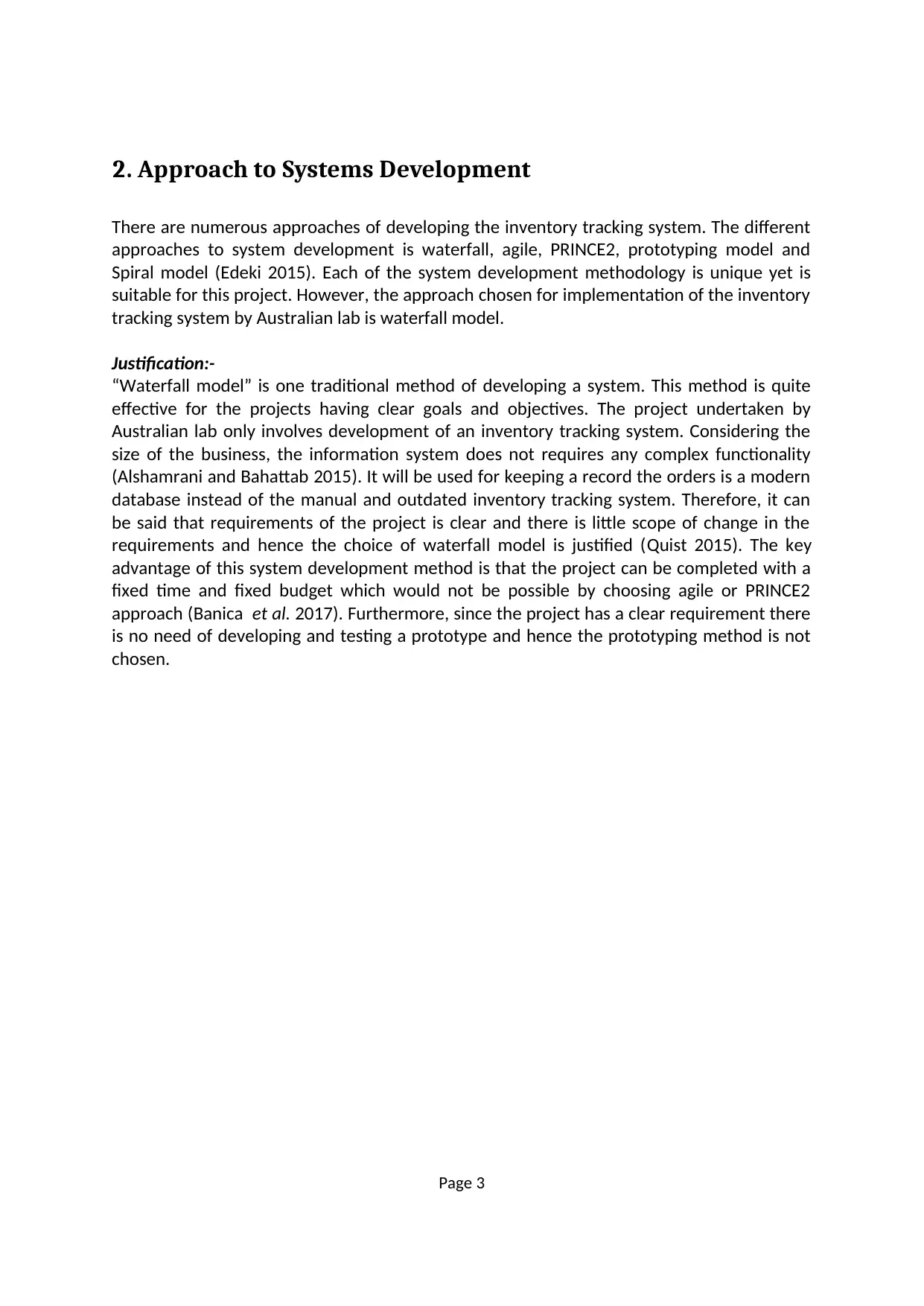
2. Approach to Systems Development
There are numerous approaches of developing the inventory tracking system. The different
approaches to system development is waterfall, agile, PRINCE2, prototyping model and
Spiral model (Edeki 2015). Each of the system development methodology is unique yet is
suitable for this project. However, the approach chosen for implementation of the inventory
tracking system by Australian lab is waterfall model.
Justification:-
“Waterfall model” is one traditional method of developing a system. This method is quite
effective for the projects having clear goals and objectives. The project undertaken by
Australian lab only involves development of an inventory tracking system. Considering the
size of the business, the information system does not requires any complex functionality
(Alshamrani and Bahattab 2015). It will be used for keeping a record the orders is a modern
database instead of the manual and outdated inventory tracking system. Therefore, it can
be said that requirements of the project is clear and there is little scope of change in the
requirements and hence the choice of waterfall model is justified (Quist 2015). The key
advantage of this system development method is that the project can be completed with a
fixed time and fixed budget which would not be possible by choosing agile or PRINCE2
approach (Banica et al. 2017). Furthermore, since the project has a clear requirement there
is no need of developing and testing a prototype and hence the prototyping method is not
chosen.
Page 3
There are numerous approaches of developing the inventory tracking system. The different
approaches to system development is waterfall, agile, PRINCE2, prototyping model and
Spiral model (Edeki 2015). Each of the system development methodology is unique yet is
suitable for this project. However, the approach chosen for implementation of the inventory
tracking system by Australian lab is waterfall model.
Justification:-
“Waterfall model” is one traditional method of developing a system. This method is quite
effective for the projects having clear goals and objectives. The project undertaken by
Australian lab only involves development of an inventory tracking system. Considering the
size of the business, the information system does not requires any complex functionality
(Alshamrani and Bahattab 2015). It will be used for keeping a record the orders is a modern
database instead of the manual and outdated inventory tracking system. Therefore, it can
be said that requirements of the project is clear and there is little scope of change in the
requirements and hence the choice of waterfall model is justified (Quist 2015). The key
advantage of this system development method is that the project can be completed with a
fixed time and fixed budget which would not be possible by choosing agile or PRINCE2
approach (Banica et al. 2017). Furthermore, since the project has a clear requirement there
is no need of developing and testing a prototype and hence the prototyping method is not
chosen.
Page 3
Secure Best Marks with AI Grader
Need help grading? Try our AI Grader for instant feedback on your assignments.
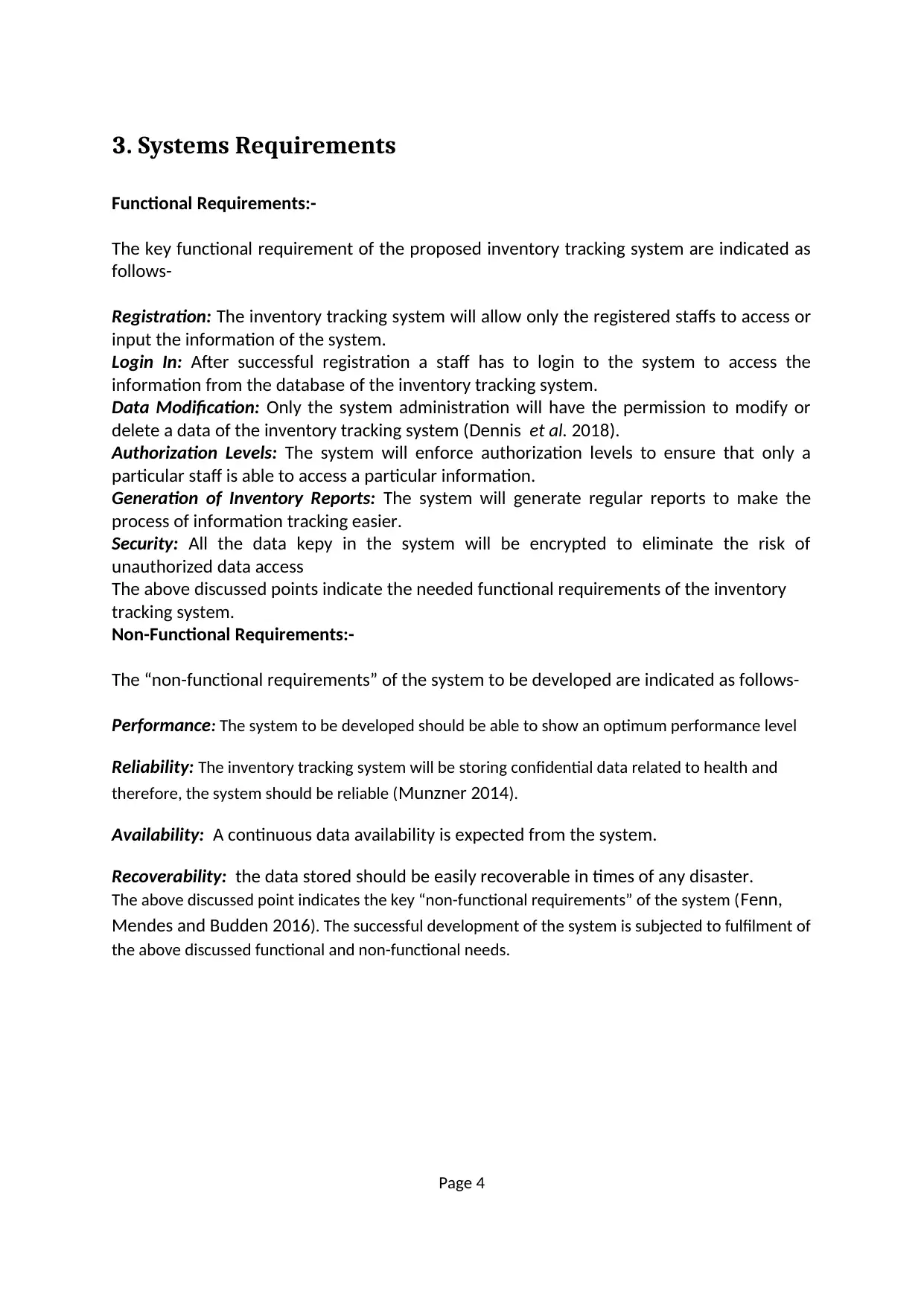
3. Systems Requirements
Functional Requirements:-
The key functional requirement of the proposed inventory tracking system are indicated as
follows-
Registration: The inventory tracking system will allow only the registered staffs to access or
input the information of the system.
Login In: After successful registration a staff has to login to the system to access the
information from the database of the inventory tracking system.
Data Modification: Only the system administration will have the permission to modify or
delete a data of the inventory tracking system (Dennis et al. 2018).
Authorization Levels: The system will enforce authorization levels to ensure that only a
particular staff is able to access a particular information.
Generation of Inventory Reports: The system will generate regular reports to make the
process of information tracking easier.
Security: All the data kepy in the system will be encrypted to eliminate the risk of
unauthorized data access
The above discussed points indicate the needed functional requirements of the inventory
tracking system.
Non-Functional Requirements:-
The “non-functional requirements” of the system to be developed are indicated as follows-
Performance: The system to be developed should be able to show an optimum performance level
Reliability: The inventory tracking system will be storing confidential data related to health and
therefore, the system should be reliable (Munzner 2014).
Availability: A continuous data availability is expected from the system.
Recoverability: the data stored should be easily recoverable in times of any disaster.
The above discussed point indicates the key “non-functional requirements” of the system (Fenn,
Mendes and Budden 2016). The successful development of the system is subjected to fulfilment of
the above discussed functional and non-functional needs.
Page 4
Functional Requirements:-
The key functional requirement of the proposed inventory tracking system are indicated as
follows-
Registration: The inventory tracking system will allow only the registered staffs to access or
input the information of the system.
Login In: After successful registration a staff has to login to the system to access the
information from the database of the inventory tracking system.
Data Modification: Only the system administration will have the permission to modify or
delete a data of the inventory tracking system (Dennis et al. 2018).
Authorization Levels: The system will enforce authorization levels to ensure that only a
particular staff is able to access a particular information.
Generation of Inventory Reports: The system will generate regular reports to make the
process of information tracking easier.
Security: All the data kepy in the system will be encrypted to eliminate the risk of
unauthorized data access
The above discussed points indicate the needed functional requirements of the inventory
tracking system.
Non-Functional Requirements:-
The “non-functional requirements” of the system to be developed are indicated as follows-
Performance: The system to be developed should be able to show an optimum performance level
Reliability: The inventory tracking system will be storing confidential data related to health and
therefore, the system should be reliable (Munzner 2014).
Availability: A continuous data availability is expected from the system.
Recoverability: the data stored should be easily recoverable in times of any disaster.
The above discussed point indicates the key “non-functional requirements” of the system (Fenn,
Mendes and Budden 2016). The successful development of the system is subjected to fulfilment of
the above discussed functional and non-functional needs.
Page 4
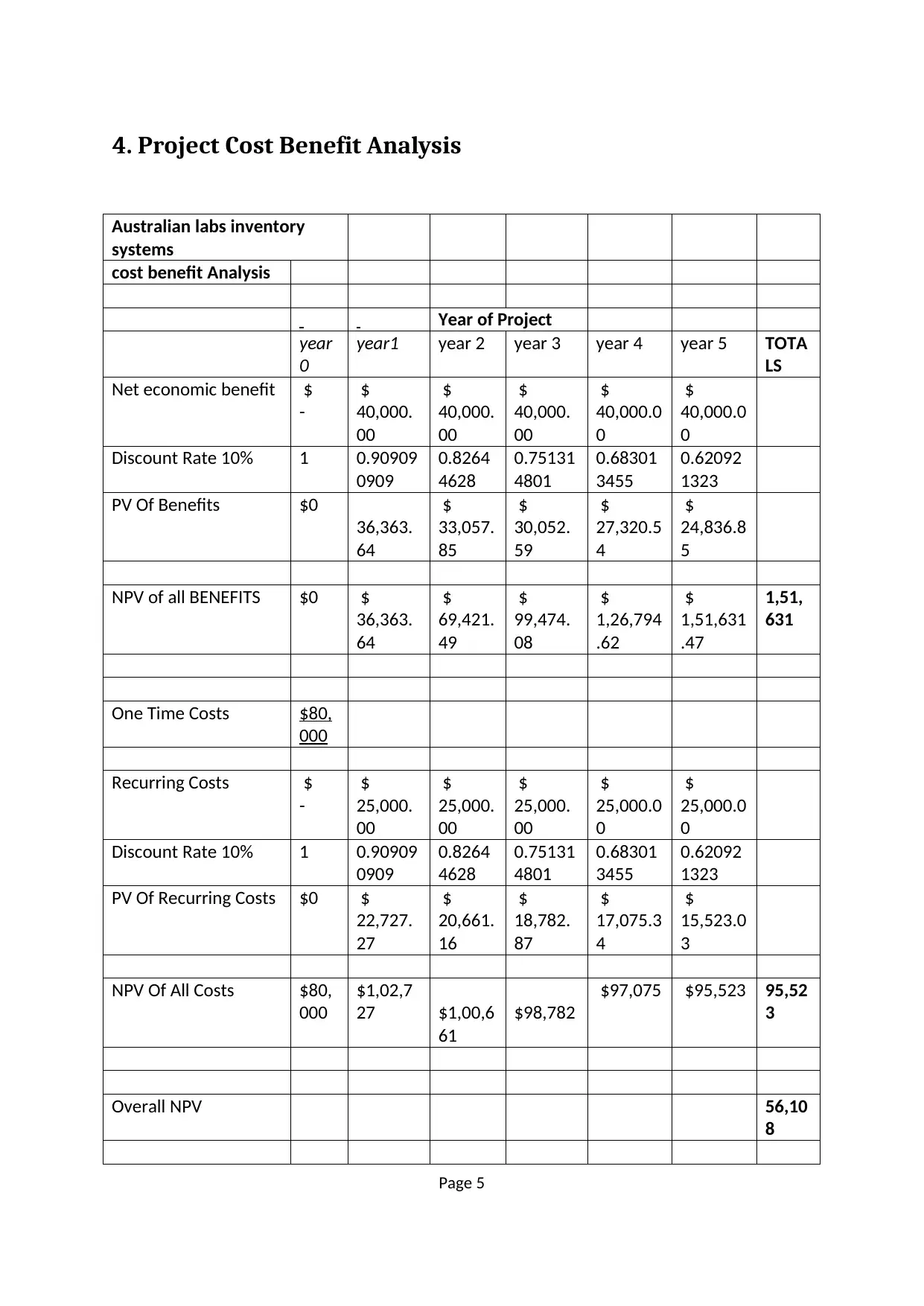
4. Project Cost Benefit Analysis
Australian labs inventory
systems
cost benefit Analysis
Year of Project
year
0
year1 year 2 year 3 year 4 year 5 TOTA
LS
Net economic benefit $
-
$
40,000.
00
$
40,000.
00
$
40,000.
00
$
40,000.0
0
$
40,000.0
0
Discount Rate 10% 1 0.90909
0909
0.8264
4628
0.75131
4801
0.68301
3455
0.62092
1323
PV Of Benefits $0
36,363.
64
$
33,057.
85
$
30,052.
59
$
27,320.5
4
$
24,836.8
5
NPV of all BENEFITS $0 $
36,363.
64
$
69,421.
49
$
99,474.
08
$
1,26,794
.62
$
1,51,631
.47
1,51,
631
One Time Costs $80,
000
Recurring Costs $
-
$
25,000.
00
$
25,000.
00
$
25,000.
00
$
25,000.0
0
$
25,000.0
0
Discount Rate 10% 1 0.90909
0909
0.8264
4628
0.75131
4801
0.68301
3455
0.62092
1323
PV Of Recurring Costs $0 $
22,727.
27
$
20,661.
16
$
18,782.
87
$
17,075.3
4
$
15,523.0
3
NPV Of All Costs $80,
000
$1,02,7
27 $1,00,6
61
$98,782
$97,075 $95,523 95,52
3
Overall NPV 56,10
8
Page 5
Australian labs inventory
systems
cost benefit Analysis
Year of Project
year
0
year1 year 2 year 3 year 4 year 5 TOTA
LS
Net economic benefit $
-
$
40,000.
00
$
40,000.
00
$
40,000.
00
$
40,000.0
0
$
40,000.0
0
Discount Rate 10% 1 0.90909
0909
0.8264
4628
0.75131
4801
0.68301
3455
0.62092
1323
PV Of Benefits $0
36,363.
64
$
33,057.
85
$
30,052.
59
$
27,320.5
4
$
24,836.8
5
NPV of all BENEFITS $0 $
36,363.
64
$
69,421.
49
$
99,474.
08
$
1,26,794
.62
$
1,51,631
.47
1,51,
631
One Time Costs $80,
000
Recurring Costs $
-
$
25,000.
00
$
25,000.
00
$
25,000.
00
$
25,000.0
0
$
25,000.0
0
Discount Rate 10% 1 0.90909
0909
0.8264
4628
0.75131
4801
0.68301
3455
0.62092
1323
PV Of Recurring Costs $0 $
22,727.
27
$
20,661.
16
$
18,782.
87
$
17,075.3
4
$
15,523.0
3
NPV Of All Costs $80,
000
$1,02,7
27 $1,00,6
61
$98,782
$97,075 $95,523 95,52
3
Overall NPV 56,10
8
Page 5
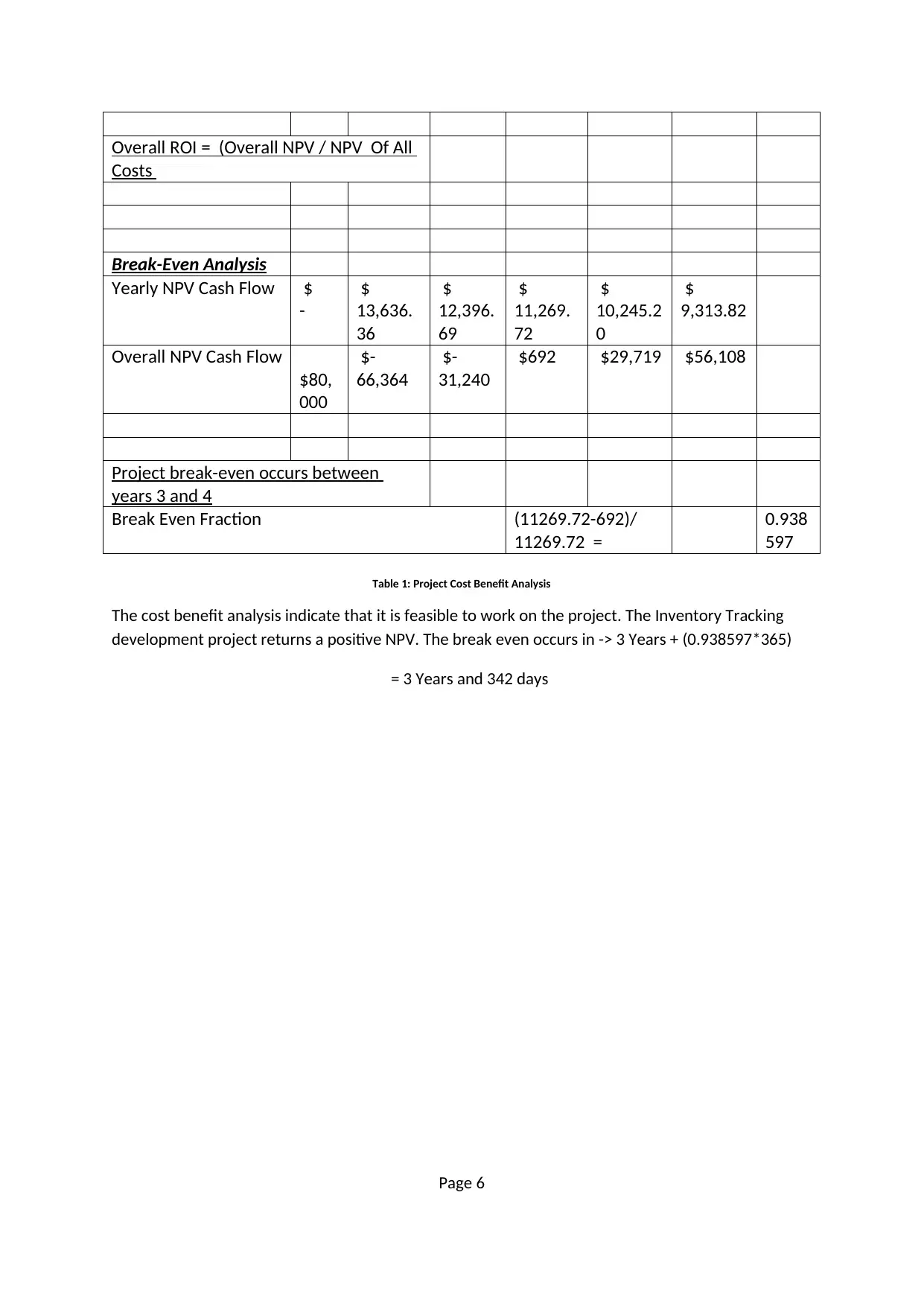
Overall ROI = (Overall NPV / NPV Of All
Costs
Break-Even Analysis
Yearly NPV Cash Flow $
-
$
13,636.
36
$
12,396.
69
$
11,269.
72
$
10,245.2
0
$
9,313.82
Overall NPV Cash Flow
$80,
000
$-
66,364
$-
31,240
$692 $29,719 $56,108
Project break-even occurs between
years 3 and 4
Break Even Fraction (11269.72-692)/
11269.72 =
0.938
597
Table 1: Project Cost Benefit Analysis
The cost benefit analysis indicate that it is feasible to work on the project. The Inventory Tracking
development project returns a positive NPV. The break even occurs in -> 3 Years + (0.938597*365)
= 3 Years and 342 days
Page 6
Costs
Break-Even Analysis
Yearly NPV Cash Flow $
-
$
13,636.
36
$
12,396.
69
$
11,269.
72
$
10,245.2
0
$
9,313.82
Overall NPV Cash Flow
$80,
000
$-
66,364
$-
31,240
$692 $29,719 $56,108
Project break-even occurs between
years 3 and 4
Break Even Fraction (11269.72-692)/
11269.72 =
0.938
597
Table 1: Project Cost Benefit Analysis
The cost benefit analysis indicate that it is feasible to work on the project. The Inventory Tracking
development project returns a positive NPV. The break even occurs in -> 3 Years + (0.938597*365)
= 3 Years and 342 days
Page 6
Paraphrase This Document
Need a fresh take? Get an instant paraphrase of this document with our AI Paraphraser
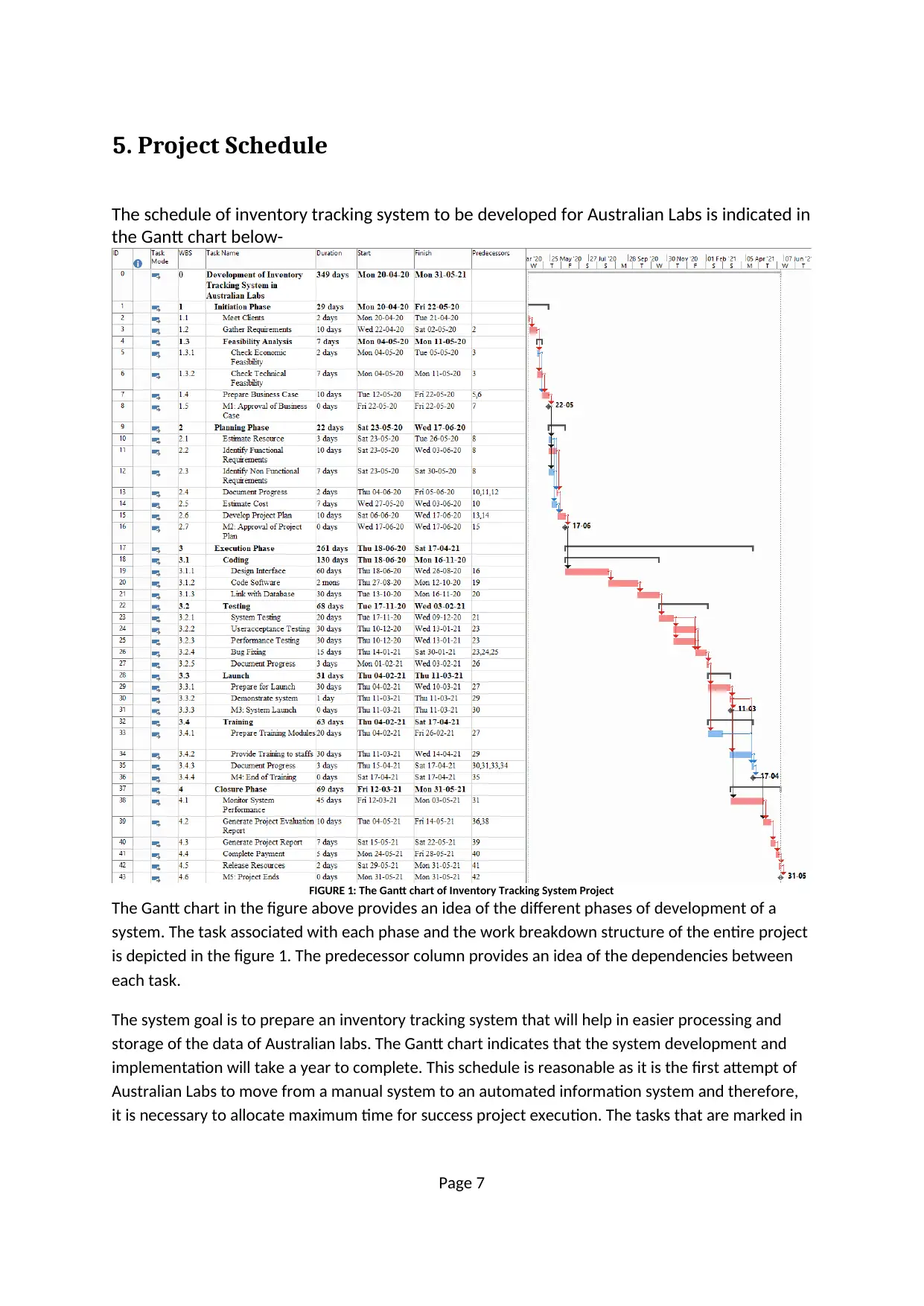
5. Project Schedule
The schedule of inventory tracking system to be developed for Australian Labs is indicated in
the Gantt chart below-
FIGURE 1: The Gantt chart of Inventory Tracking System Project
The Gantt chart in the figure above provides an idea of the different phases of development of a
system. The task associated with each phase and the work breakdown structure of the entire project
is depicted in the figure 1. The predecessor column provides an idea of the dependencies between
each task.
The system goal is to prepare an inventory tracking system that will help in easier processing and
storage of the data of Australian labs. The Gantt chart indicates that the system development and
implementation will take a year to complete. This schedule is reasonable as it is the first attempt of
Australian Labs to move from a manual system to an automated information system and therefore,
it is necessary to allocate maximum time for success project execution. The tasks that are marked in
Page 7
The schedule of inventory tracking system to be developed for Australian Labs is indicated in
the Gantt chart below-
FIGURE 1: The Gantt chart of Inventory Tracking System Project
The Gantt chart in the figure above provides an idea of the different phases of development of a
system. The task associated with each phase and the work breakdown structure of the entire project
is depicted in the figure 1. The predecessor column provides an idea of the dependencies between
each task.
The system goal is to prepare an inventory tracking system that will help in easier processing and
storage of the data of Australian labs. The Gantt chart indicates that the system development and
implementation will take a year to complete. This schedule is reasonable as it is the first attempt of
Australian Labs to move from a manual system to an automated information system and therefore,
it is necessary to allocate maximum time for success project execution. The tasks that are marked in
Page 7

red in the Gantt chart indicates the critical task of the project. The WBS column provides an idea of
the detailed WBS structure of the inventory tracking project.
Page 8
the detailed WBS structure of the inventory tracking project.
Page 8
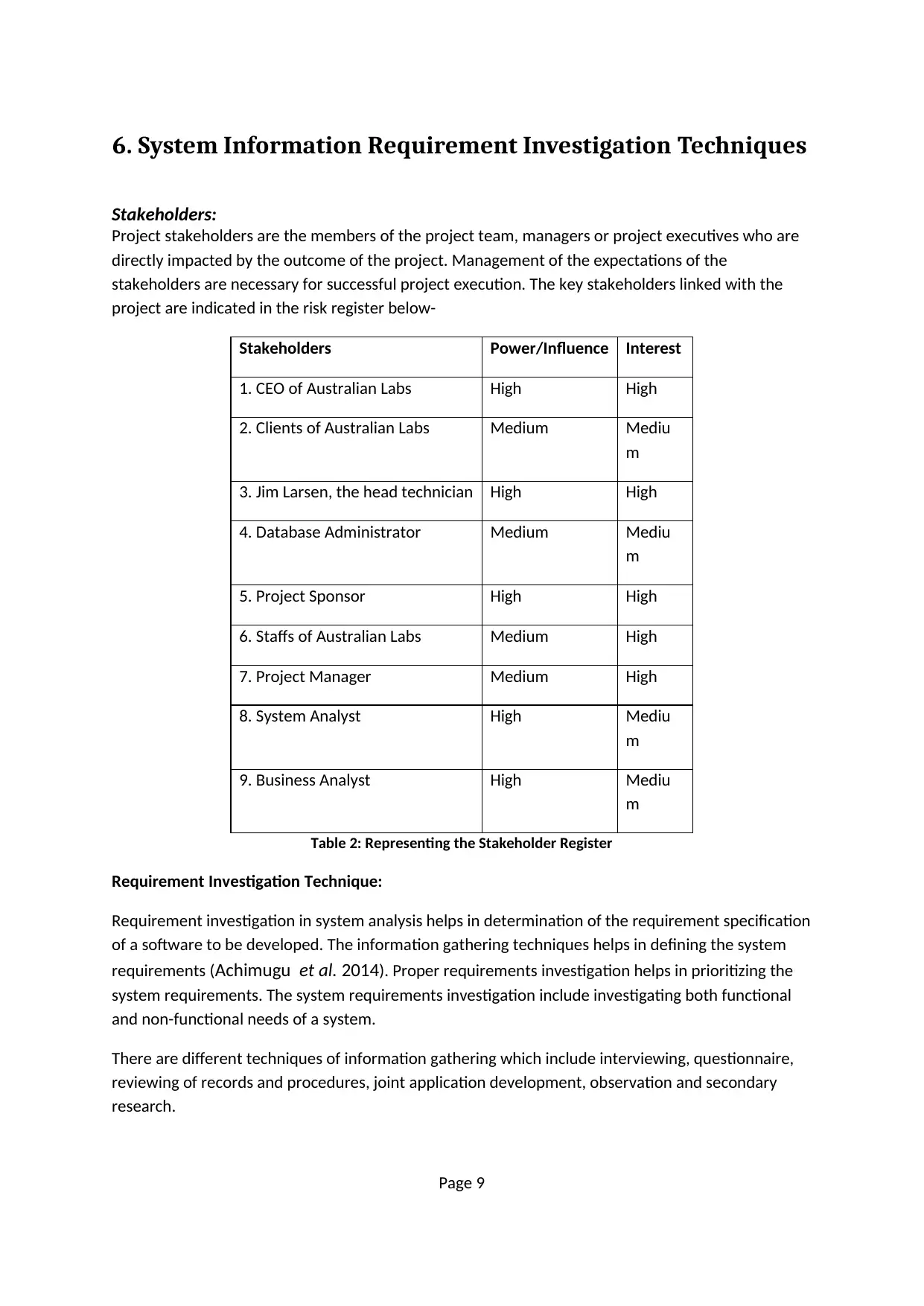
6. System Information Requirement Investigation Techniques
Stakeholders:
Project stakeholders are the members of the project team, managers or project executives who are
directly impacted by the outcome of the project. Management of the expectations of the
stakeholders are necessary for successful project execution. The key stakeholders linked with the
project are indicated in the risk register below-
Stakeholders Power/Influence Interest
1. CEO of Australian Labs High High
2. Clients of Australian Labs Medium Mediu
m
3. Jim Larsen, the head technician High High
4. Database Administrator Medium Mediu
m
5. Project Sponsor High High
6. Staffs of Australian Labs Medium High
7. Project Manager Medium High
8. System Analyst High Mediu
m
9. Business Analyst High Mediu
m
Table 2: Representing the Stakeholder Register
Requirement Investigation Technique:
Requirement investigation in system analysis helps in determination of the requirement specification
of a software to be developed. The information gathering techniques helps in defining the system
requirements (Achimugu et al. 2014). Proper requirements investigation helps in prioritizing the
system requirements. The system requirements investigation include investigating both functional
and non-functional needs of a system.
There are different techniques of information gathering which include interviewing, questionnaire,
reviewing of records and procedures, joint application development, observation and secondary
research.
Page 9
Stakeholders:
Project stakeholders are the members of the project team, managers or project executives who are
directly impacted by the outcome of the project. Management of the expectations of the
stakeholders are necessary for successful project execution. The key stakeholders linked with the
project are indicated in the risk register below-
Stakeholders Power/Influence Interest
1. CEO of Australian Labs High High
2. Clients of Australian Labs Medium Mediu
m
3. Jim Larsen, the head technician High High
4. Database Administrator Medium Mediu
m
5. Project Sponsor High High
6. Staffs of Australian Labs Medium High
7. Project Manager Medium High
8. System Analyst High Mediu
m
9. Business Analyst High Mediu
m
Table 2: Representing the Stakeholder Register
Requirement Investigation Technique:
Requirement investigation in system analysis helps in determination of the requirement specification
of a software to be developed. The information gathering techniques helps in defining the system
requirements (Achimugu et al. 2014). Proper requirements investigation helps in prioritizing the
system requirements. The system requirements investigation include investigating both functional
and non-functional needs of a system.
There are different techniques of information gathering which include interviewing, questionnaire,
reviewing of records and procedures, joint application development, observation and secondary
research.
Page 9
Secure Best Marks with AI Grader
Need help grading? Try our AI Grader for instant feedback on your assignments.
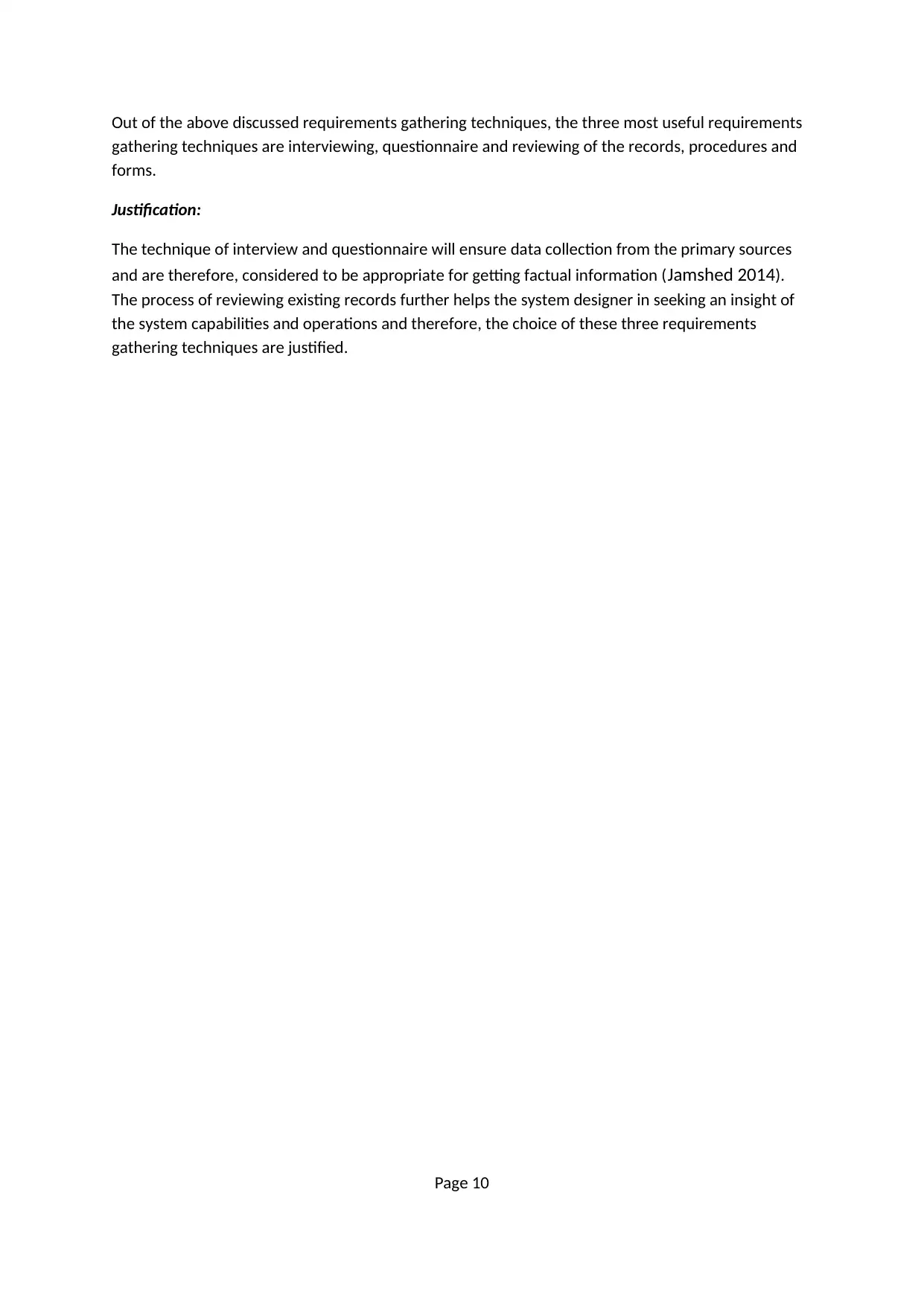
Out of the above discussed requirements gathering techniques, the three most useful requirements
gathering techniques are interviewing, questionnaire and reviewing of the records, procedures and
forms.
Justification:
The technique of interview and questionnaire will ensure data collection from the primary sources
and are therefore, considered to be appropriate for getting factual information (Jamshed 2014).
The process of reviewing existing records further helps the system designer in seeking an insight of
the system capabilities and operations and therefore, the choice of these three requirements
gathering techniques are justified.
Page 10
gathering techniques are interviewing, questionnaire and reviewing of the records, procedures and
forms.
Justification:
The technique of interview and questionnaire will ensure data collection from the primary sources
and are therefore, considered to be appropriate for getting factual information (Jamshed 2014).
The process of reviewing existing records further helps the system designer in seeking an insight of
the system capabilities and operations and therefore, the choice of these three requirements
gathering techniques are justified.
Page 10
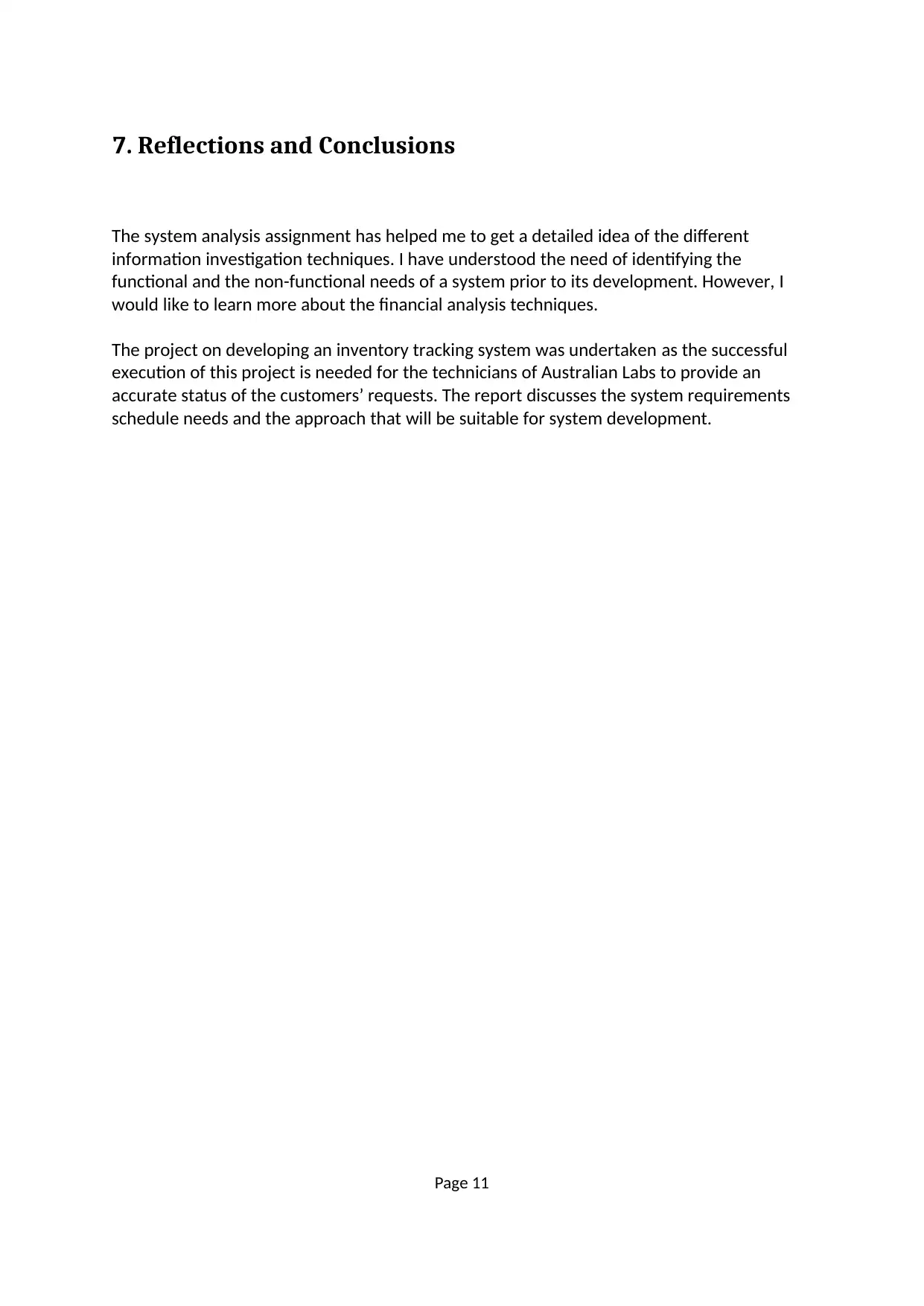
7. Reflections and Conclusions
The system analysis assignment has helped me to get a detailed idea of the different
information investigation techniques. I have understood the need of identifying the
functional and the non-functional needs of a system prior to its development. However, I
would like to learn more about the financial analysis techniques.
The project on developing an inventory tracking system was undertaken as the successful
execution of this project is needed for the technicians of Australian Labs to provide an
accurate status of the customers’ requests. The report discusses the system requirements
schedule needs and the approach that will be suitable for system development.
Page 11
The system analysis assignment has helped me to get a detailed idea of the different
information investigation techniques. I have understood the need of identifying the
functional and the non-functional needs of a system prior to its development. However, I
would like to learn more about the financial analysis techniques.
The project on developing an inventory tracking system was undertaken as the successful
execution of this project is needed for the technicians of Australian Labs to provide an
accurate status of the customers’ requests. The report discusses the system requirements
schedule needs and the approach that will be suitable for system development.
Page 11
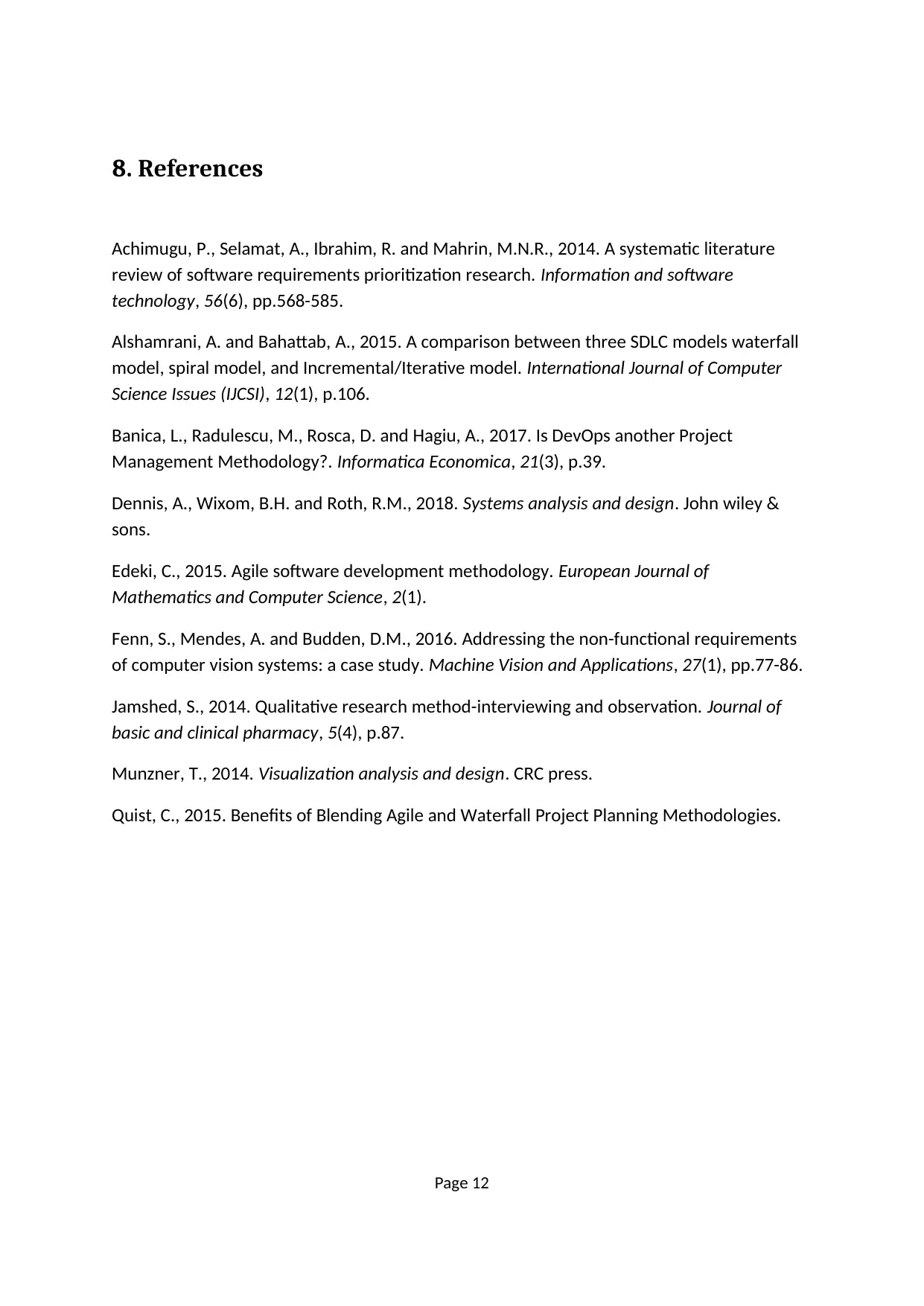
8. References
Achimugu, P., Selamat, A., Ibrahim, R. and Mahrin, M.N.R., 2014. A systematic literature
review of software requirements prioritization research. Information and software
technology, 56(6), pp.568-585.
Alshamrani, A. and Bahattab, A., 2015. A comparison between three SDLC models waterfall
model, spiral model, and Incremental/Iterative model. International Journal of Computer
Science Issues (IJCSI), 12(1), p.106.
Banica, L., Radulescu, M., Rosca, D. and Hagiu, A., 2017. Is DevOps another Project
Management Methodology?. Informatica Economica, 21(3), p.39.
Dennis, A., Wixom, B.H. and Roth, R.M., 2018. Systems analysis and design. John wiley &
sons.
Edeki, C., 2015. Agile software development methodology. European Journal of
Mathematics and Computer Science, 2(1).
Fenn, S., Mendes, A. and Budden, D.M., 2016. Addressing the non-functional requirements
of computer vision systems: a case study. Machine Vision and Applications, 27(1), pp.77-86.
Jamshed, S., 2014. Qualitative research method-interviewing and observation. Journal of
basic and clinical pharmacy, 5(4), p.87.
Munzner, T., 2014. Visualization analysis and design. CRC press.
Quist, C., 2015. Benefits of Blending Agile and Waterfall Project Planning Methodologies.
Page 12
Achimugu, P., Selamat, A., Ibrahim, R. and Mahrin, M.N.R., 2014. A systematic literature
review of software requirements prioritization research. Information and software
technology, 56(6), pp.568-585.
Alshamrani, A. and Bahattab, A., 2015. A comparison between three SDLC models waterfall
model, spiral model, and Incremental/Iterative model. International Journal of Computer
Science Issues (IJCSI), 12(1), p.106.
Banica, L., Radulescu, M., Rosca, D. and Hagiu, A., 2017. Is DevOps another Project
Management Methodology?. Informatica Economica, 21(3), p.39.
Dennis, A., Wixom, B.H. and Roth, R.M., 2018. Systems analysis and design. John wiley &
sons.
Edeki, C., 2015. Agile software development methodology. European Journal of
Mathematics and Computer Science, 2(1).
Fenn, S., Mendes, A. and Budden, D.M., 2016. Addressing the non-functional requirements
of computer vision systems: a case study. Machine Vision and Applications, 27(1), pp.77-86.
Jamshed, S., 2014. Qualitative research method-interviewing and observation. Journal of
basic and clinical pharmacy, 5(4), p.87.
Munzner, T., 2014. Visualization analysis and design. CRC press.
Quist, C., 2015. Benefits of Blending Agile and Waterfall Project Planning Methodologies.
Page 12
1 out of 13
Related Documents
Your All-in-One AI-Powered Toolkit for Academic Success.
+13062052269
info@desklib.com
Available 24*7 on WhatsApp / Email
![[object Object]](/_next/static/media/star-bottom.7253800d.svg)
Unlock your academic potential
© 2024 | Zucol Services PVT LTD | All rights reserved.





